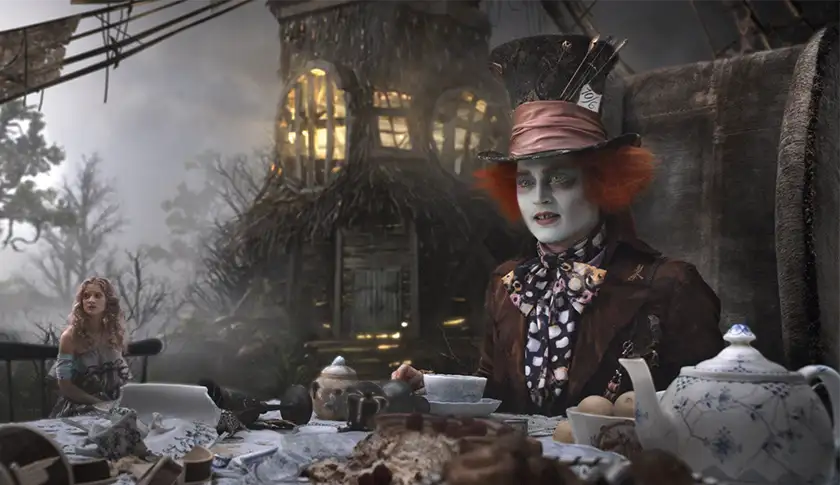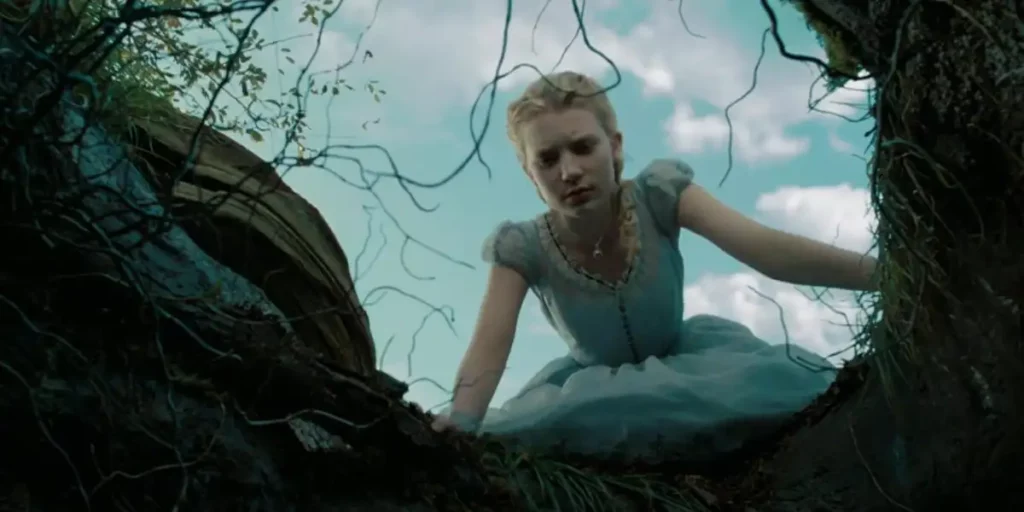Tim Burton’s Alice in Wonderland (2010) translates the themes of childhood wonder and growing up into cinematic terms.
Director: Tim Burton
Genre: Adventure, Family, Fantasy, Adaptation
Run Time: 108′
Release Date: March 5, 2010
Where to watch: on digital & VOD
“Why is a raven like a writing desk?” Asks the Mad Hatter (Johnny Depp) in Alice in Wonderland. The first time I watched the film, the question stayed with me so much that I kept asking all the adults in my life, searching for an answer that would satisfy me. At the time, I was barely a teenager and certainly younger than the protagonist of the movie, and yet Tim Burton’s film spoke to me in many ways.
As the years passed, I found myself re-visiting the film over and over and discovering that I could always find something new to enjoy and appreciate, no matter at what age I watched it.
Set in 1868, Alice in Wonderland follows Alice Kingsleigh (Mia Wasikowska, of Club Zero), a 19-year-old woman struggling with societal pressure over marriage and with the recent loss of her father. Alice also recalls having the same strange nightmare that she has always had since she was a kid. At a garden party where she is expected to accept an unwanted marriage proposal by Hamish Ascot (Leo Bill), Alice spots a White Rabbit (Michael Sheen, of Good Omens) with a pocket watch and follows him down a rabbit hole which will take her to Wonderland. Here, she will meet friends – including the Mad Hatter, the White Queen (Anne Hathaway, of Mothers’ Instinct), and the Cheshire Cat (Stephen Fry, of The Sandman) and foes, such as the evil Red Queen (Helena Bonham Carter, of One Life).
In Wonderland, everybody is looking for Alice, as they all believe she will be the one to help restore the White Queen to her rightful throne by defeating a terrifying dragon called Jabberwocky that the Red Queen uses to terrorise the kingdom. This may all seem absurd – to everyone but Alice, since she’s convinced that this is nothing but a dream for the entire first half of the film – but the protagonist will soon learn that this is very much real, in more ways than one. In fact, Alice in Wonderland also portrays Alice’s transition into adulthood: the physical journey into Wonderland mirrors a psychological journey of personal growth in the main character. In this sense, the adaptation is very insightful as Alice’s search for identity becomes one of the main pillars the movie stands on.

As she gets ready to fight the Jabberwocky, the biggest lesson that Alice has to learn is how to live her life for herself, rather than to please others. While the challenges that she faces may be fictional, they represent very real struggles that Alice faces outside of Wonderland, which are explored in much more depth in Burton’s adaptation compared to the original book by Lewis Carroll. In Alice’s real life, everyone expects her to get married to the most eligible prospect and forget all about her dreams and ambitions. And yet, her imagination and childlike curiosity are the attributes that make her the Alice that everybody is looking for in Wonderland. “Sometimes I believe in as many as six impossible things before breakfast,” she says at the end of Alice in Wonderland, reminding us that even as grown-ups we should always nurture our desire for imagination and adventure.
The theme of childhood wonder is not only present in the plot and narrative of Alice in Wonderland, which essentially mirrors that of fairytales, but also in its visuals. From the moment Alice falls down the rabbit hole, everything looks as if this were a dream: from the vibrant colours to the uniquely designed talking animals she meets, Wonderland immediately looks different from the real world the protagonist momentarily leaves behind. In this sense, the film is particularly impressive in the way it portrays Wonderland and its inhabitants: each of the characters and each of the settings we see throughout the movie is unique, making everyone and everything stand out from the moment they first appear on the screen.
Further rewatches of the film have each inspired me to see the movie differently and to appreciate every aspect of it, from both a technical and narrative standpoint. However, the one thing that always remains is its positive message, which encourages us to maintain child-like qualities of imagination and wonder. Most recently, the answer to the Mad Hatter’s cryptic riddle finally came to me: a raven is like a writing desk because they both have quills. And yet, if there is anything we can learn from Alice in Wonderland, it is that there is no fixed answer to any riddle – just like there is no pre-determined way to lead our lives – and we can very much make up our own answer and pave our way into this world. So, do you have any idea of why a raven is like a writing desk? Maybe a further rewatch of Tim Burton’s movie will inspire you to find your own answer.
Alice in Wonderland (2010) was released globally in theaters on March 5, 2010 and is now available to watch on digital and on demand. Read our ranking of all the Disney live action movies!
Loud and Clear Reviews has an affiliate partnership with Apple, so we receive a share of the revenue from your purchase or streaming of the films when you click on the button on this page. This won’t affect how much you pay for them and helps us keep the site free for everyone.

